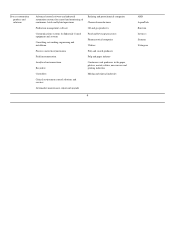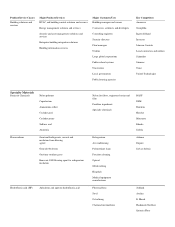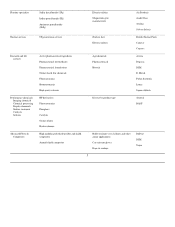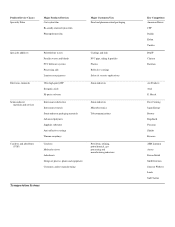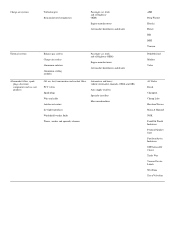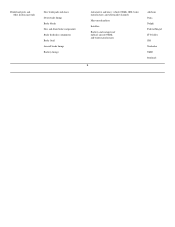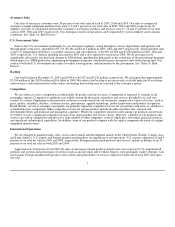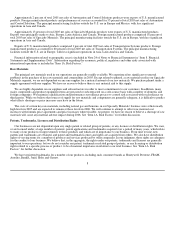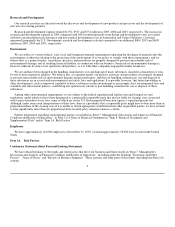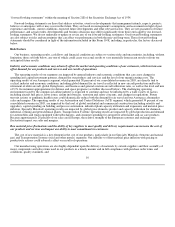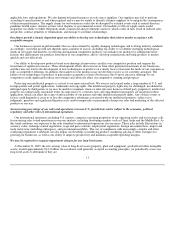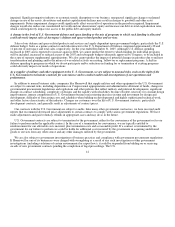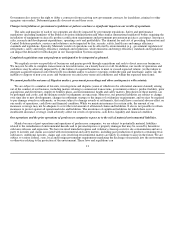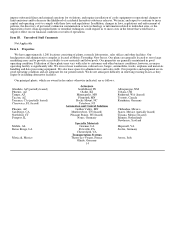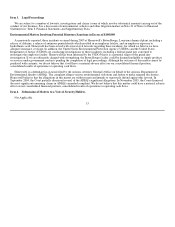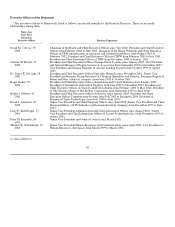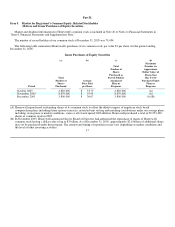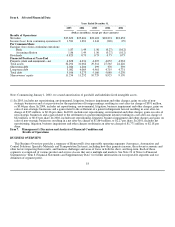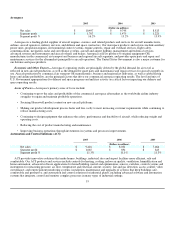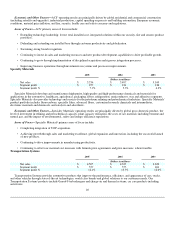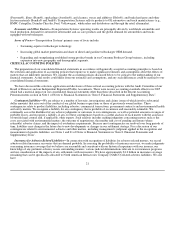Honeywell 2005 Annual Report Download - page 22
Download and view the complete annual report
Please find page 22 of the 2005 Honeywell annual report below. You can navigate through the pages in the report by either clicking on the pages listed below, or by using the keyword search tool below to find specific information within the annual report.
applicable laws and regulations. We also depend in limited instances on sole source suppliers. Our suppliers may fail to perform
according to specifications as and when required and we may be unable to identify alternate suppliers or to mitigate the consequences
of their non-performance. The supply chains for our businesses could also be disrupted by external events such as natural disasters,
pandemic health issues, terrorist actions, labor disputes or governmental actions. Our inability to fill our supply needs would
jeopardize our ability to fulfill obligations under commercial and government contracts, which could, in turn, result in reduced sales
and profits, contract penalties or terminations, and damage to customer relationships.
Our future growth is largely dependent upon our ability to develop new technologies that achieve market acceptance with
acceptable margins.
Our businesses operate in global markets that are characterized by rapidly changing technologies and evolving industry standards.
Accordingly, our future growth rate depends upon a number of factors, including our ability to (i) identify emerging technological
trends in our target end-markets, (ii) develop and maintain competitive products, (iii) enhance our products by adding innovative
features that differentiate our products from those of our competitors, and (iv) develop, manufacture and bring products to market
quickly and cost-effectively.
Our ability to develop new products based on technological innovation can affect our competitive position and requires the
investment of significant resources. These development efforts divert resources from other potential investments in our businesses,
and they may not lead to the development of new technologies or products on a timely basis or that meet the needs of our customers as
fully as competitive offerings. In addition, the markets for our products may not develop or grow as we currently anticipate. The
failure of our technologies or products to gain market acceptance or their obsolescence due to more attractive offerings by our
competitors could significantly reduce our revenues and adversely affect our competitive standing and prospects.
Protecting our intellectual property is critical to our innovation efforts. We own or are licensed under a large number of U.S. and
foreign patents and patent applications, trademarks and copyrights. Our intellectual property rights may be challenged, invalidated or
infringed upon by third parties or we may be unable to maintain, renew or enter into new licenses of third party proprietary intellectual
property on commercially reasonable terms. In some non-U.S. countries, laws affecting intellectual property are uncertain in their
application, which can affect the scope or enforceability of our patents and other intellectual property rights. Any of these events or
factors could diminish or cause us to lose the competitive advantages associated with our intellectual property, subject us to
judgments, penalties and significant litigation costs, and/or temporarily or permanently disrupt our sales and marketing of the affected
products or services.
An increasing percentage of our sales and operations is in non-U.S. jurisdictions and is subject to the economic, political,
regulatory and other risks of international operations.
Our international operations, including U.S. exports, comprise a growing proportion of our operating results and our strategy calls
for increasing sales to and operations in overseas markets, including developing markets such as China, India and the Middle East. As
this trend continues, our exposure to the risks attendant to international operations also increases. These risks include fluctuations in
currency value, exchange control regulations, wage and price controls, employment regulations, foreign investment laws, import and
trade restrictions (including embargoes), and government instability. The cost of compliance with increasingly complex and often
conflicting regulations worldwide can also impair our flexibility in modifying product, marketing, pricing or other strategies for
growing our businesses, as well as our ability to improve productivity and maintain acceptable operating margins.
We may be required to recognize impairment charges for our long-lived assets.
At December 31, 2005, the net carrying value of long-lived assets (property, plant and equipment, goodwill and other intangible
assets) totaled approximately $14.3 billion. In accordance with generally accepted accounting principles, we periodically assess our
long-lived assets to determine if they are
11


